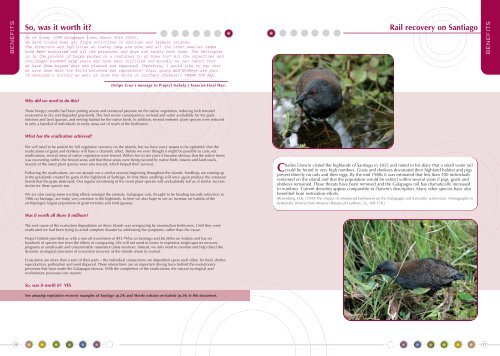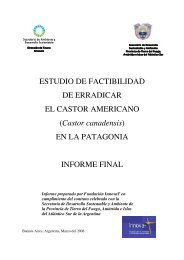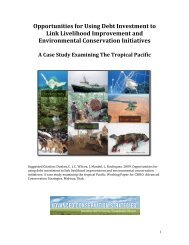Isabela eps:Layout 1 - Advanced Conservation Strategies
Isabela eps:Layout 1 - Advanced Conservation Strategies
Isabela eps:Layout 1 - Advanced Conservation Strategies
You also want an ePaper? Increase the reach of your titles
YUMPU automatically turns print PDFs into web optimized ePapers that Google loves.
RESULTS & EFFORT<br />
28<br />
Santiago: Judas phase<br />
Judas goats strategy outcomes<br />
FACT BOX<br />
Helicopter facts<br />
• 13,390 km flown of which:<br />
- 2%(2004), 97%(2005), 1%(2006)<br />
• 9.6 days non-stop equivalent<br />
Ground facts<br />
• August 2004 to July 2005<br />
• 14 trips<br />
General facts<br />
• 913 Judas released on checks<br />
• 284 Captured & translocated<br />
Judas goats on Santiago<br />
Judas goats were monitored by ground and aerial<br />
hunting crews on Santiago about 1,400 times.<br />
Ground hunters invested 5,010 hours and dogs<br />
7,720 hours, while 231 helicopter hours were<br />
flown. Kills in this phase accounted for 1% of all<br />
goats killed on Santiago. Some 617 goats were<br />
killed associated with Judas goats; 319 and 298<br />
were killed by aerial and ground checks respectively.<br />
A further 557 goats were killed unassociated with<br />
Judas goats; 97 and 460 were killed by aerial and<br />
ground checks respectively. On average, ground<br />
hunter checks were nine times more expensive than<br />
helicopter checks. However, as dogs detected more<br />
goats that were not associated with Judas goats, the<br />
final costs per goat killed during this phase were<br />
almost identical for helicopter and ground crews.<br />
Group sizes of goats killed during the Judas goat<br />
phase on Santiago. Purple dots indicate feral goats<br />
killed that were not associated with Judas goats. Pink<br />
dots are feral goats that were shot while associated<br />
with Judas goats.<br />
Ideal helicopter country<br />
<strong>Isabela</strong>: aerial hunting phase<br />
FACT BOX<br />
Hunting results<br />
On <strong>Isabela</strong>, helicopter crews removed 98% of all goats; the terrain and vegetation was, in general, ideal for aerial hunting.<br />
Goats were shot on all volcanoes, with the highest densities occurring on Alcedo, Darwin and Wolf. Aerial hunting was<br />
extremely efficient and allowed areas to be covered that would have been near impossible to cover by foot. One area<br />
proved difficult to hunt from the air. Dense vegetation on the southern slopes of Alcedo was hunted intensively but many<br />
animals still remained. Goats altered their behavior, becoming motionless and hiding under vegetation where they were<br />
generally safe from detection by aerial crews. Methods were switched after aerial hunting had removed all the animals<br />
possible (read further p.30).<br />
Period: May, June & December 2004 + January<br />
to March 2005<br />
• 56,657 goats eradicated<br />
• 98% of total goats eradicated<br />
• 46,664 in 2004 & 9,993 in 2005<br />
• 54% eradicated 0-500 m. alt.<br />
• 33% eradicated 500-1000 m. alt.<br />
• 13% eradicated > 1000 m. alt. & inside craters<br />
* Unlike on Santiago Island, no black goats were seen<br />
on <strong>Isabela</strong> Island<br />
Hunting km flown<br />
• 72.761 km total (1.8 times the earth’s circumference)<br />
• 43,957 km in 2004<br />
• 27,533 km in 2005<br />
• 1,271 km in 2006<br />
Hunting hrs flown<br />
• 1,258 hrs total (52.4 days non-stop)<br />
• 930 hrs in 2004<br />
• 312 hrs in 2005<br />
• 16 hrs in 2006<br />
Tracking on down <strong>Isabela</strong><br />
With Santiago’s recent experience fresh in their<br />
minds, the helicopter crews were well prepared<br />
when they arrived on <strong>Isabela</strong>. After a general<br />
orientation flight aimed at identifying some of the<br />
goat’s living areas, the hunting phase was<br />
launched. A whole month based on volcano Wolf<br />
enabled them to work the northern part of <strong>Isabela</strong><br />
thoroughly, flying more and spending more time<br />
than originally planned due to the unexpected<br />
high number of goats.<br />
After being based at a temporary camp<br />
on northern <strong>Isabela</strong>, the group then<br />
moved to the permanent camp where<br />
they were based until the end of March<br />
2006; Cowley base in Alfaro Point, on<br />
the eastern side of <strong>Isabela</strong>. From there,<br />
work was targeted on Alcedo and<br />
Darwin. Alcedo stands out as the<br />
problematic volcano as it had the<br />
largest goat population. Hunting flying<br />
time and kilometers flown are on a<br />
different magnitude than any previous<br />
job! The flying tracks on the map show<br />
how all of Alcedo area is suitable for<br />
goats, as opposed to any other volcano<br />
where more lava areas restrict the<br />
populations into the smaller reduced<br />
vegetated regions.<br />
29<br />
RESULTS & EFFORT





